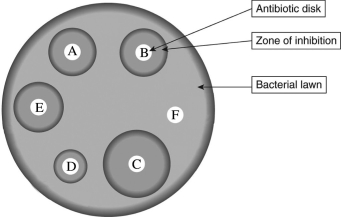Multiple Choice
Scenario
In order to test the susceptibility of bacteria (if the bacteria are susceptible to being killed) to an antibiotic, a common laboratory test called the Bauer-Kirby Disk Diffusion test is used. First, a petri dish (a shallow, circular, transparent dish with a flat lid) is partially filled with nutrient-enriched agar (a gelatinous material) . The nutrients encourage growth of specific bacterial species. The agar is poured as liquid but then typically solidifies to a soft consistency. Once the agar is set, a "lawn" of bacteria is spread such that a thin layer covers the top of the agar. Antibiotics are then applied to the lawn in a small dose, often through small, saturated paper disks. The dish is typically incubated for 24-48 hours and then observed for susceptibility. If the antibiotic is effective, it will kill the bacteria and leave a clear area called the "zone of inhibition" due to inhibited bacterial growth. The area starts at the source of the antibiotic and radiates outward. Scientists measure the diameter of the zone and then compare it to an established "cutoff value" for a zone specific to antibiotic/organism combinations. A large zone of inhibition in comparison to the standard indicates susceptibility while a small or no zone indicates resistance. Consider the following image, and answer the questions that follow: 
-What can you conclude about the susceptibility of the bacteria to the antibiotics?
A) The bacteria are more susceptible to antibiotic A than antibiotic C.
B) The bacteria are more susceptible to antibiotic D than antibiotic B.
C) The bacteria are more susceptible to antibiotic C than antibiotic E.
D) The bacteria are more susceptible to antibiotic D than antibiotic A.
Correct Answer:

Verified
Correct Answer:
Verified
Q18: In the Hardy-Weinberg formula, what does 2pq
Q19: The presence of freckles is due to
Q20: Disruptive selection can lead to _.<br>A)a decrease
Q21: Natural selection can be defined as _.<br>A)the
Q22: _ introduced a system for grouping species
Q24: The founder effect differs from a population
Q25: During his trip on the Beagle, Darwin
Q26: Homology is evidence of _.<br>A)binomial classification<br>B)artificial selection<br>C)natural
Q27: Which result might be a consequence of
Q28: Which statement is TRUE?<br>A)Natural selection works on